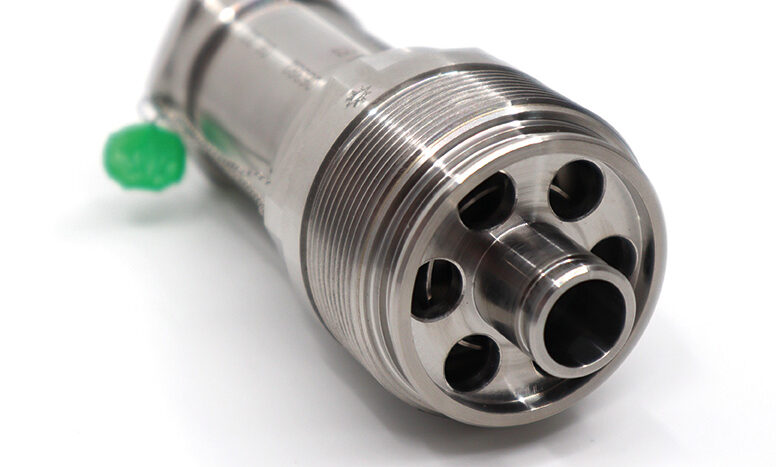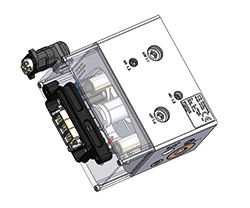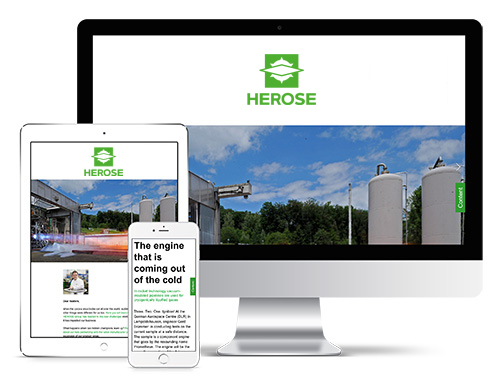The climate-friendly transport revolution has begun. Energy sources such as green hydrogen are being used, and these call for new technological solutions.

Safety first – also, of course, when using hydrogen as a source of energy on passenger trains. On routes where there is no electrification, the fuel cell drive ensures an emission-free mobility.
An important detail in the train‘s hydrogen tank system is the Gas Handling Unit (GHU). The GHU from Argo-Anleg reduces the high-pressure hydrogen in the tank system to a low-pressure level for use in the fuel cell. The Gas Handling Unit is protected by a safety valve from HEROSE, which was specially developed within a tight time frame for this application.
Hydrogen technology specialist: Argo-Anleg
As a special plant manufacturer, Argo-Anleg has acquired a lot of experience in the field of hydrogen. In this case, the company is providing the gas handling unit for a passenger train and has been involved in the project for around two years. The train is already running, validation has taken place and approvals had to be provided for the market entry phase, for example, for the safety valve of the GHU. This is where HEROSE comes into the project: with a very extensive product portfolio, with a lot of know-how in the field of engineering and with an efficient test facility and experience in product approval.
The GHU – a lot of technology in a small space
The hydrogen tank system is mounted under a bonnet on the roof of the train. The space in the roof of the passenger train is limited, so a space-saving solution is needed here. The gas handling unit from Argo-Anleg combines various components in a very compact unit that is only about the size of a shoebox. This is where the valves to reduce the pressure of 350 bar of hydrogen in the tank system to about 12 bar for use in the fuel cell are located, and this is also where the safety valve is located. Plus, there are electrical connections to retrieve the sensor data and control the GHU.
High demands
The low-pressure side of the GHU – ultimately also the fuel cell – is protected by a safety valve. If the pressure is too high, this valve responds and diverts the medium safely. The catalogue of requirements that Argo-Anleg presented to HEROSE for the valve was challenging: materials suitable for hydrogen, a strictly limited installation volume, a wide pressure range from 8 to 40 bar and a tight delivery schedule. Weekly project meetings were arranged in order to implement the cooperation for the joint project efficiently and in a time-saving manner.
The cooperation was very constructive and the result a complete success.
Franz-Heinrich Suilmann, Argo-Anleg, Design Manager Tank Systems and Valves
A finished safety valve in just a few months
A valve that could be fundamental to the development was quickly identified in the HEROSE product portfolio. However, this valve had to shrink to almost half its size – but still retain its performance. The use of as many common parts from the portfolio as possible has a significant cost-saving effect. The time factor of the project also required expanding and upgrading an existing HEROSE safety valve approval. This resulted in a finished overflow valve within a few months, which was used on the trains in the GHU during the technology validation phase. Within 2 months, the overflow valve became a safety valve complete with approval.
A 180 degree turnaround and a shrinking process
The standard HEROSE safety valves are designed as angle valves, which means that when triggered, the medium is expelled at a 90 degree angle. The valve specified in the Argo-Anleg valve block receives the medium from below and also discharges it downwards – a deflection of 180 degrees and a constructional challenge. The mounting thread for the valve was predetermined by the valve block and the overall height was limited.
Solution-oriented cooperation and lots of fine-tuning
Three prototypes of the housing were produced at HEROSE. However, until the desired result was achieved in joint work and the overflow valve could be designed, tested and delivered, numerous changes were made to various details. Now the normative requirements of a safety valve had to be applied to the overflow valve. Fine-tuning at its most sophisticated was called for here. This was followed by a series of tests with component changes in the tenths of a millimetre range with various modifications to the lifting aid and disc. The function and performance of the safety valve in conformity with the approval was verified on the test bench and approved by the appraiser – a great joint success within a short period of time.
Hydrogen trains – the new generation
Market readiness is there: next year we will be travelling in passenger trains that use hydrogen as a fuel. Fuel cell propulsion is the solution, especially in areas where there are no overhead lines yet or where electrification is not profitable – the zero emissions and quiet operation also make this type of propulsion interesting for inner-city areas and nature reserves.
High-performance and future-proof mobility
When cold combustion takes place in the fuel cell, hydrogen and oxygen react to form water, resulting in heat and electrical energy. The new technology makes these trains as powerful as conventional multiple-unit electric trains. The energy is used for the on-board system and, of course, to operate the electric motors for the traction – batteries as intermediate storage ensure sufficient energy in all driving situations. The hydrogen drive has a high level of efficiency and a long service life. The system can be quickly refuelled and allows the train to run for a whole day – with a range of up to 1000 kilometres.

For over 20 years, this company has specialised in the construction of special hydrogen plants – from the conceptual design to the finished plant: hydrogen filling stations, hydrogen systems for HGVs, trains and ships. Individual special solutions are created hand-in-hand with the customer. A gas handling unit for 700 bar tank systems is currently under development.
Photo at the top: Siemens Mobility GmbH



 Read the current digital customer magazine now!
Read the current digital customer magazine now!
